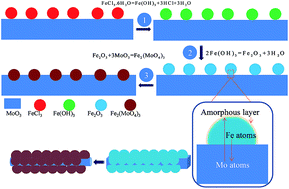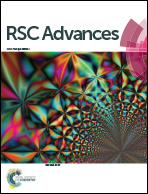Fe2(MoO4)3 nanoparticle-anchored MoO3 nanowires: strong coupling via the reverse diffusion of heteroatoms and largely enhanced lithium storage properties†
Abstract
A novel hierarchical heterostructured Fe2(MoO4)3@MoO3 (FM) nanowire is developed by mild hydrothermal treatment of precursor MoO3 nanobelts with only the assistance of FeCl3·6H2O combined with the heat treatment. Subsequently, a model of reverse heteroatoms diffusion is proposed to describe the formation of FM nanowires. Further, it is found that the heteroatoms diffusion and facet-selective growth of Fe2(MoO4)3 on MoO3 nanobelts brought about the change of MoO3 morphology from nanobelts to nanowires, and Fe2(MoO4)3 nanoparticles are firmly anchored onto MoO3 nanowires. When tested as LIBs anodes, compared to pristine MoO3 nanobelts, high reversible lithium storage capacities of the anodes are obtained from novel FM nanowires. The FM nanowire electrode obtained at 500 °C (FM-500) exhibits superior reversible capacity of 585 mA h g−1 retained at a current density of 100 mA g−1 after 100 cycles, and 518 mA h g−1 retained after 100 cycles at 200 mA g−1. The distinct electrochemical activity of the Fe2(MoO4)3 nanoparticles probably activates the irreversible capacity of the MoO3 nanobelts. Moreover, the amorphous layer and structure stability of heterojunction electrodes are also beneficial for charge storage, electron transfer and lithium ion diffusion during the charge–discharge process.


 Please wait while we load your content...
Please wait while we load your content...